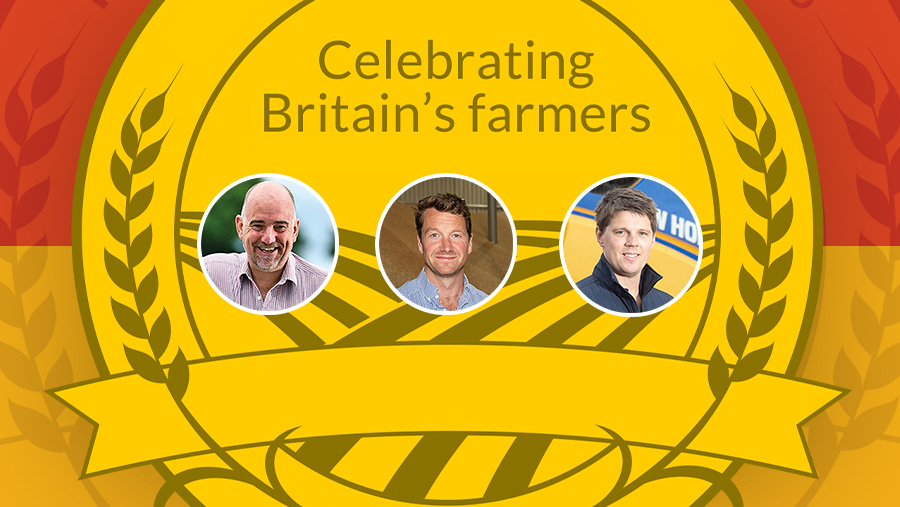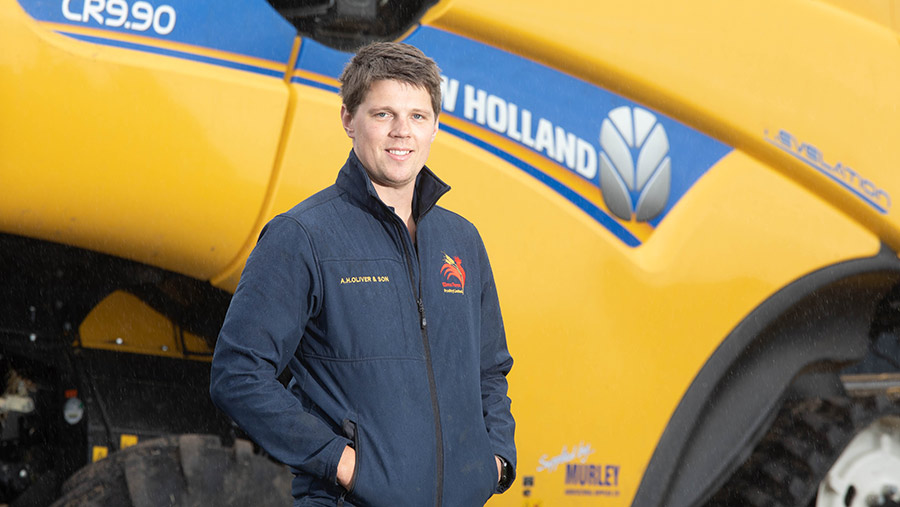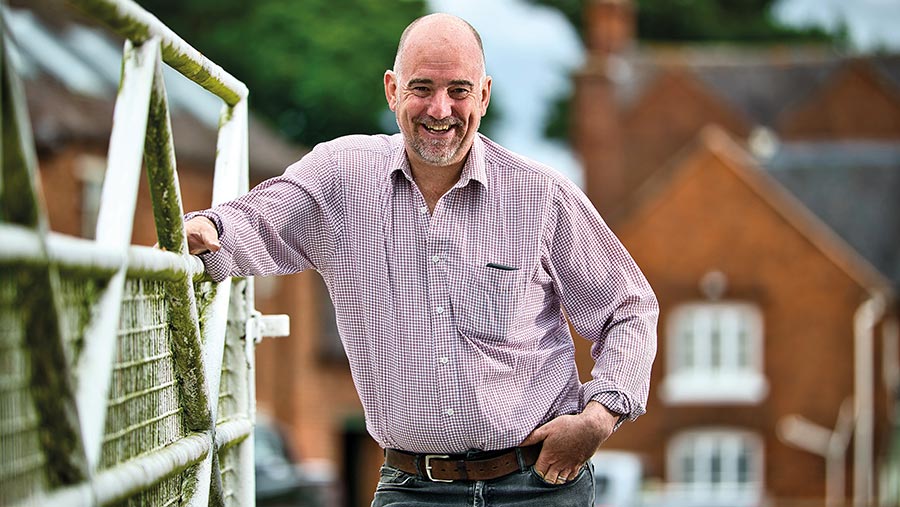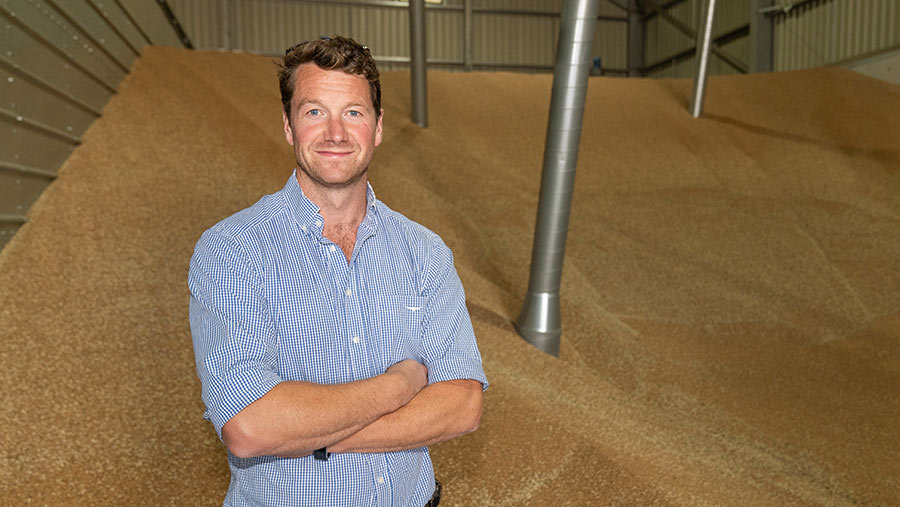Farmers Weekly Awards: Arable farmer finalists 2020

While the three finalists run very different cropping systems, they all have diverse rotations, a drive to improve efficiency and are looking to get their arable businesses ready for life without BPS payments.
The 2020 Arable Farmer of the Year finalists
- William Oliver
Swepstone Fields Farm, Leicestershire - Tim Parton
Brewood Park Farm, West Midlands - Robert Price
Rooksnest Estate, Berkshire
The judges
The judging team will visit each finalist on their farm for an interview and tour. The Arable Farmer of the Year judges are:
- Scott Campbell
Last year’s winner - Richard Allison
Farmers Weekly arable editor , - Andrew Blazey
Independent judge and AICC agronomist
See also: Farmers Weekly Awards: Pig Farmer finalists 2020
William Oliver
Swepstone Fields Farm, Leicestershire
Bosworth was the scene of the final battle in the War of the Roses and, more than 500 years later, William Oliver is leading the charge against grassweeds in the same fields.

William Oliver, Arable farmer finalist 2020 © Tim Scrivener
He is the fourth generation of the Oliver family to farm the area and his zero-tolerance approach to blackgrass means he is now on top of grassweeds.
William has also battled to cut costs and is now growing first wheat for £85/t by making full use of poultry litter and digestate, as well as exploiting mapping technology to precisely target inputs across his fields.
Challenges
William graduated from Harper Adams University College in 2011 and returned home to manage the family arable business.
One challenge was blackgrass, and six years ago, he recalls spraying off 25ha of crop to prevent seed return. The wheat, OSR, wheat rotation was also no longer sustainable.
Cost of production was too high and he needed to trim fungicide, fertiliser and other input costs. With oilseed rape, the increased cost was due to having to grow Clearfield varieties because of a high erucic acid issue.
Changes
William took on the agronomy himself. Walking all the fields, he is thriving under pressure, making all the key cropping decisions. It also means fungicides and can be applied at the optimum time.
He has overhauled the rotation, introducing a more diverse cropping mix with the addition of spring beans, spring barley, potatoes and, more recently, grain maize.
He has taken a zero-tolerance approach to blackgrass based on maximising cultural controls and, as a last resort, using chemistry.
He is a firm believer in using variable-rate technology for seeding along with applying variable rates of N, P, K and lime.
Other key changes include moving to 36m tramlines and trialling new break crops such as grain maize.
Achievements
William’s robust approach to grassweeds is paying off and he is now spraying off less than 0.4ha a year. He has also cut costs and can produce wheat for an impressive £85/t – down from £130-140t/ha before he did his own agronomy.
Some of this success is down to slashing fertiliser costs by using poultry litter and digestate, the former coming from the family’s new 200,000-bird broiler enterprise.
The poultry litter alone has slashed ammonium nitrate costs by £26,640. And there are the other soil health benefits.
William has also cut his oilseed rape establishment costs from £92/ha to £51/ha by changing to a Weaving LD Top-Soiler.
Adopting precision farming techniques means all his inputs are focused where needed with less wastage.
However, he is achieving this at a fraction of the cost offered by specialist firms. He calculates the cost at just £8.30/ha for variable seeding, N,P, K and lime. He estimates that P, K and lime alone gives a £37/ha benefit over flat-rate applications.
The combination of these fertiliser savings, along with using ground source heat pumps to heat the poultry sheds and reduced diesel use, means he has cut his carbon footprint by 36% to 3,200t of carbon dioxide equivalents a year.
So like the battle of Bosworth, a pivotal moment which saw England prosper for years after, William’s overhaul of the cropping system at Swepstone Fields farm means the business is well placed for the changes in store after Brexit.
What the judges say
William has lots of passion and enthusiasm in producing crops and is willing to try new things like growing grain maize. He is making good use of poultry litter and digestate and has a very good handle on his costs.”
Summary
The judges liked
• Passion for growing crops and trying new things
• Good use of digestate and chicken muck
• Knows his cost of precision farming
• Good staff policy and staff are well motivated
• Knows his carbon footprint
Farm facts
• 800ha of arable cropping
• Cropping includes wheat, oilseed rape, spring beans, spring barley, potatoes and grain maize
• Establishment based on rotational ploughing, cultivations with a Vaderstad Carrier and Amazone Cirrus drill
• Soils mainly clay/loam with some lighter land
The numbers
• 36% The reduction in carbon footprint
• £85/t Cost to produce first wheat
• £26.6k Saving in ammonium nitrate bill by using poultry manure
• £37/ha Benefit from variable rate P, K and lime
• £9/ha Total cost of precision farming
Tim Parton
Brewood Park Farm, West Midlands
Tim Parton has always been interested in soils and every cropping decision he makes at Brewood Park Farm aims to support the delicate soil fungi that help crops to prosper.

Tim Parton, Arable farmer finalist 2020 © Stanton
In 2010, he adopted strip-tillage and initially thought that was the solution. But he realised that much more could be gained with no cultivation and, five years ago, he made the next step and has dramatically slashed inputs by working with biology.
He has developed a low-input system that is producing wheat for £65/t while at the same time delivering double-digit wheat yields and improving soil health.
Challenges
Ten years ago, he recalls, the biggest challenge he faced was that yields had plateaued due to poor soil health and “they were exhausted from years of synthetic inputs”.
He explains: “We were putting more and more N on but yields were flatlining – we were getting just as good yields in the 1970s.” So he knew it was time for change.
Ploughing was burning off lots of carbon from the soil and in fuel, and he describes it as “pulling a ball and chain” through soil fungi, which he believes is the key to getting the most from soils and crops.
He believes the heavy reliance on insecticides and fungicides was having the opposite effect. So he set out to learn more about soil biology and overhauled the system.
Changes
Tim’s aim is to make the most of soil biology, as plants can benefit from symbiotic relationships with soil bacteria and fungi. This relationship helps plants fight disease and it releases nutrients that were locked up. “We needed to get soils working,” he says.
The first part of his overhaul was to stop cultivating soil by adopting direct drilling, as soil fungi are too delicate to withstand the soil disturbance.
He acquired a John Deere 750i which he has modified as he also wanted a drill that could place microbes down the spout with the seed.
The rotation was overhauled resulting in 50:50 winter and spring cropping to enable cover cropping.
With oilseed rape, he started undersowing with a companion clover to encourage mycorrhizal fungi, as OSR is not a host.
He has also added value by growing premium crops such as beans for seed, lupins for seed, malting barley and milling wheat.
Tim is also using all the latest technology, including novel sap testing of crops to indicate disease risk, and is doing variable-rate inputs.
Achievements
Tim describes his system as “beyond organic” and has achieved a huge amount by focusing on soil biology.
It has enabled him to slash inputs. He hasn’t used any insecticides for five years, relying on beneficials, and also no longer uses pre-emergence herbicides. Last year, he produced wheat spending £30/ha on weed control, £40/ha on disease management and with an average yield of 10.52t/ha.
The end result is that his cost of production for wheat is about £65/t while at the same time he is securing milling premiums.
By working with biology, soil health continues to improve, with organic matter rising by 0.2% a year and greater worm numbers.
He has cut fertiliser use through a combination of applying soil fixing bacteria and greater use of foliar N, saving £55,000 a year.
Looking ahead, he believes that in two years’ time he will be close to being carbon neutral as he cuts inputs even further and soils continue to improve.
What the judges say
Tim is passionate about biological farming and has gained an impressive knowledge of soil biology. He has shown much innovation adapting his direct drill to apply microbial brews and has very strong environmental credentials.”
Summary
The judges liked
• Enthusiasm and passion for biological farming
• Strong innovation, such as adapting his direct drill
• Grain marketing and adding value to crops
• Very strong environmental credentials leading to increased wildlife
• Immaculate machinery and well kept farmyard
Farm facts
• 300ha of arable cropping
• Cropping includes milling wheat, malting barley, beans, lupins, oats, oilseed rape and grass for haylage
• Establishment based on John Deere 750i direct drill
• Soils: mainly sandy loams and clay loams
The numbers
• 0 No insecticides have been used for five years
• £65/t Cost to produce first wheat
• £55k Saving in nitrogen fertiliser over 10 years ago
• 5,000 Litres of diesel saved each year
• 0.2% Annual increase in soil organic matter
Robert Price
Rooksnest Estate, Berkshire
The Lambourne valley is well known for its racehorses and, like many successful trainers, Robert Price looks to produce a winning performance – which has meant overhauling the arable business at Rooksnest Estate.

Robert Price, Arable farmer finalist 2020 © Tom Askew-Miller
Nestled in the valley, the farm’s challenging soils mean he is never going to see the very high yields achieved on much kinder soils. Instead, he is focused on adding value where he can by earning valuable premiums.
Cutting costs is also a key aim, and a change in establishment system and the adoption of controlled traffic farming has brought a big cut in fuel use.
Challenges
He recalls that the system was under pressure and with the combine up for renewal, it was the ideal time to review what he was doing and question some of the crop choices.
Winter barley and oilseed rape were grown as an early entry for wheat, while rye/maize for anaerobic digestion were in the rotation to help reduce workload.
However, they were in the hands of contractors and it wasn’t to Robert’s high standards.
Having one combine cutting 1,700ha meant the team, as well as the premiums, were under pressure as they looked to cut milling wheat, milling oats and malting barley at the optimum time to maintain quality.
Another problem was rising costs. “Costs were creeping up on establishment,” he says.
There was also blackgrass, a problem he acquired when taking on a 260ha farm.
Changes
Over the past seven years, he has implemented a hybrid 12m controlled traffic farming system with 36m tramlines, and one of the last pieces of the CTF jigsaw was the new 12m Horsch Serto drill. The drill has enabled shallower cultivations, a valuable part of Robert’s blackgrass strategy, and increasing the drilling capacity to 100ha/day allows later drilling.
He has also joined a local benchmarking group to help him identify any further savings.
The single combine was replaced by two, increasing capacity from 120ha to 200ha a day. This has enabled Robert to grow a more diverse rotation with nine different crops including beans, blue peas and herbage.
He also saw an opportunity to tap into the local hay for racehorses market.
Robert is also making full use of technology, mapping fields and using variable-rate seeding and nutrition to get the most from his inputs.
Achievements
He is reaping the rewards of adopting controlled traffic farming and new drill, with fuel costs falling by 15%. There will also be a longer-term soil health benefit.
He is now earning premiums that are worth a total of £120,000, with herbage being a good example of maximising returns. The crop is generating three incomes: seed, hay for racehorses and grazing for lambs.
More timely harvesting has also brought savings of up to £8,000 a year in drying costs, as well as reducing driver fatigue.
One success Robert and his team are particularly proud of is successfully getting on top of a blackgrass problem at Fishers farm, with ear counts in 2019 at 40-50/ha in the worst areas, a fraction of what they were three years earlier.
Robert believes he has found the balance between commercial arable farming and environment management. However, like racehorse trainers, he looks to further raise performance.
Future plans include increasing the herbage area, further reducing his tractor horsepower and, by 2024, having a business ready for life without BPS payments.
What the judges say
Robert has identified the limitations of his soils and it’s impressive how much value he is extracting from his crops by focusing on premiums. He has a motivated team and is good at developing young people.”
Summary
The judges liked
• Strong focus on staff training and development
• Diverse cropping rotation
• Targeting premiums to add value to crops
• Clear vision on machinery policy, like the move from one to two combines
• Very impressive and even-looking linseed crop
Farm facts
• 1,700ha of arable cropping
• Cropping includes feed and milling wheat, winter barley, malting barley, blue peas, milling oats, linseed, oilseed rape, winter/spring beans and herbage
• Establishment based on 12m Horsch Serto drill and 12m Horsch Joker cultivator
• Soils range heavy clay to light chalky down land
The numbers
• 12t/ha Average yield of last year’s milling wheat which hit 13% protein
• 12m Controlled traffic farming system is based on this width, with 36m tramlines
• £116k Total value of crop premiums a year
• 100% All nitrogen fertiliser is applied as liquid
• 126ha Area of linseed grown in 2020
Sponsor’s message
 “Arable farmers have shown terrific resilience and fortitude in a very challenging year with the FW finalists being great examples of this. While genetics and technology will help address many future challenges, the innovation, commitment and sheer skill of growers is equally important.”
“Arable farmers have shown terrific resilience and fortitude in a very challenging year with the FW finalists being great examples of this. While genetics and technology will help address many future challenges, the innovation, commitment and sheer skill of growers is equally important.”
Will Compson
UK country manager, KWS

